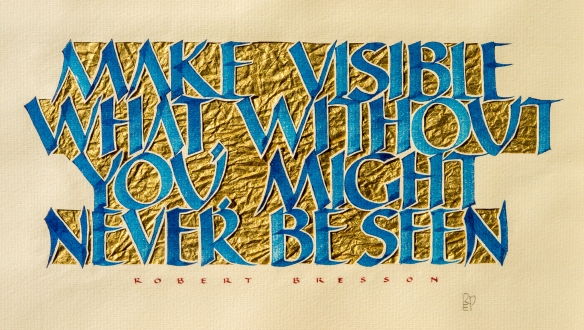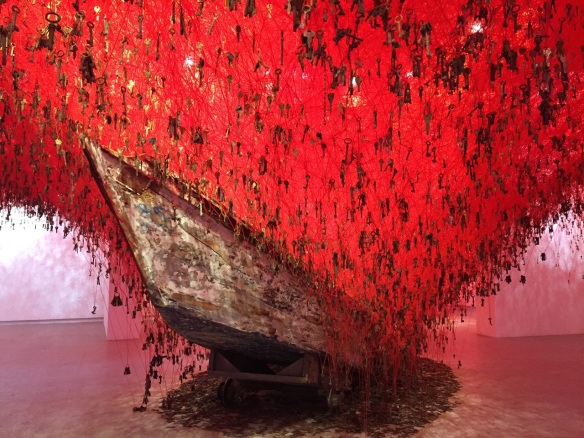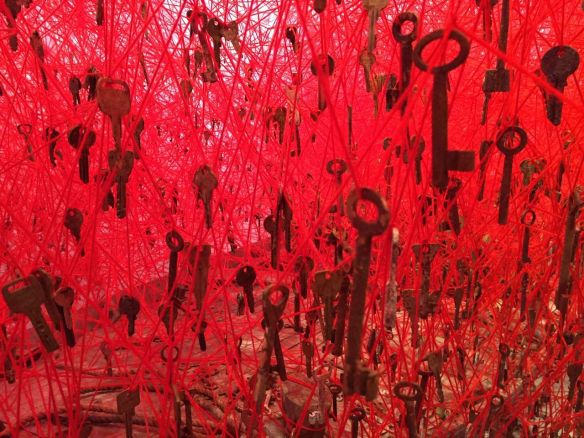
Alexander Sokurov, “Lc. 15:11-32” (Prodigal Son installation, 2019). Sculptures by Vladimir Brodarsky & Katya Pilnikova.
Life is a dialectic of dwelling and wayfaring, in the world yet not of it.
––– Erazim Kohák
I once was lost, but now I’m found.
––– John Newton
Jesus’ parable of the Prodigal Son is the Bible’s preeminent tale of forgiveness and reconciliation. The welcoming father’s embrace of his foolish and errant son is a vividly concise summary of the gospel message: We can never be so lost that we cannot be found. We can never be so wrong that we cannot be loved.
Rembrandt’s celebrated painting, The Return of the Prodigal Son, would be one of his final works. He was bankrupt, his style no longer in vogue. His wife and three of their children were long dead, and he would have to sell his wife’s grave to pay his debts. His only surviving son Titus, age 27, died of the plague even as the parable’s “lost son” was taking form on canvas. As Rembrandt struggled with his own sadness and despair, he created the most indelible image of mercy in the history of art.
Father and son emerge from a world of shadows, for compassion is the light of the world which no darkness can comprehend. The arch formed by the father’s welcoming arms is echoed by the arched doorway in the background, showing love to be the true way home. And unlike most other artistic depictions of this scene, there is no happy glance between the reunited pair. The prodigal’s repentant posture delays the moment when their eyes will meet.
Kierkegaard wrote at length about the “infinite qualitative abyss” between God and humanity, a condition due not only to the uncrossable difference between finite and infinite, but also to the profound estrangement from the holy wrought by human sin. Given the magnitude of the gulf between ourselves and the divine, how could we ever be in relation with One who is so totally other? “The danger,” said Kierkegaard, “is that God becomes so dreadfully and irreconcilably Other to the self that one is swallowed up by the horror of this infinite qualitative abyss.” [1]
The modern solution to the gulf between human and divine has been to ignore (or forget entirely) the Holy Other and concentrate on the human situation in solely human terms, permanently severing the problem of earthly existence from the problem of God. How well that works is a matter of some debate, but for the faithful, such a strategy omits far too much of value. Exiling God from the world is not a solution for our own condition of exile.

The Prodigal Son under the melancholy gaze of Rembrandt’s “Portrait of an Old Woman” (1654) in Sokurov’s installation.
We all long to go home, to find the place where we are loved and known and welcomed, the place where all wanderings cease, and we can finally know what it means to dwell. But with the longing comes doubt. Is there such a place? Can we ever get there? And how will the journey change us?
For the unbeliever, human life concludes with annihilation. After our last breath––nothing. But the future of the believer may also be described as a kind of annihilation. As we draw near the absolute center of all that is, the egocentric self can no longer maintain its pretentious fictions. The really Real exposes our own unreality. The gaze of God is fatal to our illusions.
When Moses asked to see God’s face, God told him that “no human may look upon Me and live” (Exodus 33:20). This crucial Hebrew text reflects an ancient fear of direct contact with the divine, whose infinite voltage could fry the circuits of finite beings. But the biblical God posed an additional, even greater threat: the penetrating gaze which sees us for what we are.
Day of wrath! . . .
What a great tremor there will be,
when the Judge is to come,
who will examine all things strictly . . .
I groan, as if accused;
my face blushes because of my fault . . . [2]
Who among us is ready to have every story told, every failure examined, every blemish known? Therapeutic honesty is hard and painful work. Kierkegaard wrote in his Journal that “to see yourself is to die, to die to all illusions and all hypocrisy––it takes great courage to look at yourself.” And, he added, this “can only take place in the mirror of the Word.” [3]
The Christian goals of illumination and divine union must be preceded by confession and purgation. “If we say we have no sin, we deceive ourselves, and the truth is not in us” (I John 1:8). Even the saints are not exempt; the best of them are brutally honest about their own incompleteness. St. John of the Cross, speaking from personal experience, said that the journey of faith “does not consist in consolations, delights, and spiritual feelings, but in the living death of the cross, sensory and spiritual, exterior and interior.” [4]
This annihilation of self––“the living death of the cross”––is not morbid self-hatred (fixating on my sin is just another form of ego), but the abandonment of everything false or misshapen as the necessary prelude to profound transformation. The death of self becomes the beginning of Self.
I abandoned and forgot myself,
laying my face on my Beloved;
all things ceased;
I went out from myself,
leaving my cares
forgotten among the lilies. [5]
In Rembrandt’s painting, the Prodigal Son presses his face against his father’s comforting body. He is still in the confessional stage, kneeling with downcast eyes, not yet daring to stand face-to-face with the one he has hurt so deeply. But consciousness of his fault is overcome by grace––the leap of faith which accepts the “impossible possibility” of being forgiven. Only by knowing ourselves as sinners needing mercy can we become aware of forgiveness. The eyes which were cast down by shame will soon be raised up to see the welcoming father face-to-face. “By surrendering its despair before God, the self becomes open to forgiveness: the gift from the divine which is the impossible possibility of coming to know oneself as one is known by God.” [6]
The Kierkegaardian surrender of existential despair in order to receive the gift of mercy applies perfectly to Rembrandt’s painting:
“Justice looks judgingly at a person, and the sinner cannot endure its gaze; but love, when it looks at him––yes, even if he avoids its gaze, looks down, he nevertheless does perceive that it is looking at him, because love penetrates far more inwardly into life, deep inside life, in there where life emanates, than justice does, which repellingly establishes a chiasmic abyss between the sinner and itself, whereas love is on his side, does not accuse, does not judge, but pardons and forgives.” [7]
The Return of the Prodigal Son, acquired by St. Petersburg’s Hermitage Museum over 250 years ago, has long haunted the imagination of Russian visual artists. In his metaphysical sci-fi film Solaris (1972), Andrei Tarkovsky returns his cosmonaut protagonist from the “far country” of outer space to the door of his childhood house, where he is embraced like Rembrandt’s prodigal. But his father, we have learned, is deceased, and his son remains somewhere out in space, light years from earth. Tarkovsky’s moving image of ultimate reunion with both parent and planet earth turns out to be only memory or dream. It is in fact “impossible”––which only deepens the desire to make it so.

The son returns home (in his imagination), from the closing scene of Andrei Tarkovsky’s “Solaris” (1972).
Another Russian filmmaker, Alexander Sokurov, included Rembrandt’s actual painting in Russian Ark (2002), a meditation on Russia’s troubled history filmed entirely inside the Hermitage in a single 87-minute shot, with the camera moving through the galleries to encounter both paintings and people from different centuries. The pensive French aristocrat we follow from room to room stops for a long time in front of Rembrandt’s great canvas, silently paying homage to its power. For the Russian Pavilion at this year’s Venice Biennale, Sokurov himself returns to the painting, rethinking its themes with sculpture, video, music, lighting, a mirror, and various objects from an artist’s studio. His installation is called “Lc. 15:11-32,” after the biblical citation for Luke’s telling of the parable.
In the first of two dark rooms, father and son stand far apart in the gloom. It is not clear whether they even see each other across the black abyss that separates them. Behind the father are two large video projections representing a world gone wrong. One shows a blurred image of a city dissolving in flames, like an apocalypse by Hieronymus Bosch. The other shows Christ sitting in a desert as soldiers enter with flame throwers to fill the screen with fire and smoke. We realize that not just the son, but the whole world has gone astray. Not even a divine father can fix it. Grace and redemption remain an impossibility in this terrifying darkness.
The Christ in the video image is taken from a nineteenth-century Russian painting, Christ in the Wilderness (1872), by Ivan Nikolaevich Kromskoy, whose humanized Jesus, unlike the serenely transcendent Savior of Orthodox iconography, reflected the revolutionary and questioning mood of the painter’s generation. In an age of religious doubt, traditional understandings seemed out of touch with experience. For Kromskoy, a self-assured Christ radiant with divinity was too detached from human suffering. “My God––Christ––is the greatest of atheists,” he said, “a person who has destroyed God in the universe and shifted him directly to the center of the human spirit and who, therefore, goes calmly to his death.” [8]

One of the video projections in the first room of Alexander Sokurov’s installation, “Lc. 15:11-32.”.
But how calm can such a Christ really be, sitting now, according to Sokurov, amid the flames and smoke of our endless desert wars? He may be the “fellow sufferer who understands,”[9] but he appears to be as lost as the Prodigal Son, exiled to the far country of human sin. His inheritance of divine power has been squandered by incarnation. He may share our griefs––does he also share our helplessness?
In the vast first room of Sokurov’s installation, estrangement is absolute and unchanging. But beyond it lies a second room, like a small cave, where the abyss of sin and separation is overcome at last. In a sculpted restaging of Rembrandt’s painting, the lost son comes home to the father’s compassionate embrace.
Behind the figures there is a large mirror, whose reflected image repeats the scene, reminding us that every retelling of the parable is but a version of an original which cannot be grasped directly, but only experienced in the second-hand reflections of Luke, Rembrandt, Sokurov, and all the rest of us who engage Jesus’ story. The mirror’s surface is slightly wavy, and it sways slowly back and forth, producing a continuously distorted image, suggesting the instability and uncertainty of every interpretation.
The mirror also includes the viewer, allowing each of us to know ourselves as witnesses to the impossible mystery of divine mercy. But such seeing does not always come naturally. While I stood transfixed in this cave of revelation, two young women entered. After a brief glance at the sculpture, they became absorbed with photographing their own misshapen reflections in the mirror, giggling at the funhouse gag.
In my mind, I judged their heedless frivolity, and the moment I did so I became equally blind to the meaning of The Return. I forgot my own prodigal culpability, my own need to kneel with downcast eyes. I forgot the unconditional nature of the father’s embrace. I had become the elder brother.
No matter, says the parable. The prodigal, the proud, the penitent, the foolish––we’ll all be gathered in eventually. And the conclusion of all our wandering stories will be a home of abiding welcome. The door is open. The feast is ready. Love is waiting. Come.
Related Posts:
The Return of the Prodigal Son
Venice Biennale 2019: “A wound in a dance with love”
[1] Søren Kierkegaard, Without Authority, cited in Simon D. Podmore, Kierkegaard and the Self Before God: Anatomy of the Abyss (Bloomington, IN: Indiana University Press, 2011), 8.
[2] Dies Irae (“Day of Wrath”), a thirteenth-century Latin poem about the Last Judgment and our collective plea for forgiveness. It became a traditional part of requiem masses, but its vivid images of doom and “wrath” sound jarring to modern ears accustomed to a kinder and gentler eschatology. However, when we consider the moral and apocalyptic implications of climate change, the notion of a “day of reckoning” when “nothing will remain unpunished” and “even the just can scarcely be secure” seems uncomfortably apt, as does the poem’s anguished cry for rescue and “the gift of forgiveness.”
[3] Kierkegaard Journal, cited in Podmore, 155.
[4] John of the Cross, cited in Hans Boersma, The Beatific Vision in Christian Tradition (Grand Rapids, MI: Eerdmans, 2018), 184.
[5] John of the Cross, “The Dark Night,” cited in Boersma, 178.
[6] Podmore, 179.
[7] Kierkegaard, Without Authority, cited in Podmore, 173-174.
[8] Ivan Kromskoy in a letter to a friend, quoted in Walther K. Lang, “The ‘Atheism’ of Jesus in Russian Art: Representations of Christ by Ivan Kromskoy, Vasily Polenov, and Nikolai Ghe,” I recommend the entire article for those interested in art and faith. It is found on the website Nineteenth-Century Art Worldwide: http://www.19thc-artworldwide.org/autumn03/272-the-qatheismq-of-jesus-in-russian-art-representations-of-christ-by-ivan-nikolevich-kramskoy-vasily-polenov-and-nikolai-ghe
[9] Alfred North Whitehead’s famous description of God has provided a moving and influential image of a divinity deeply affected by human suffering, a God who takes our pain into Godself. Critics of such theology wonder whether too much divine power has been relinquished. Can a vulnerable God still save us?









































